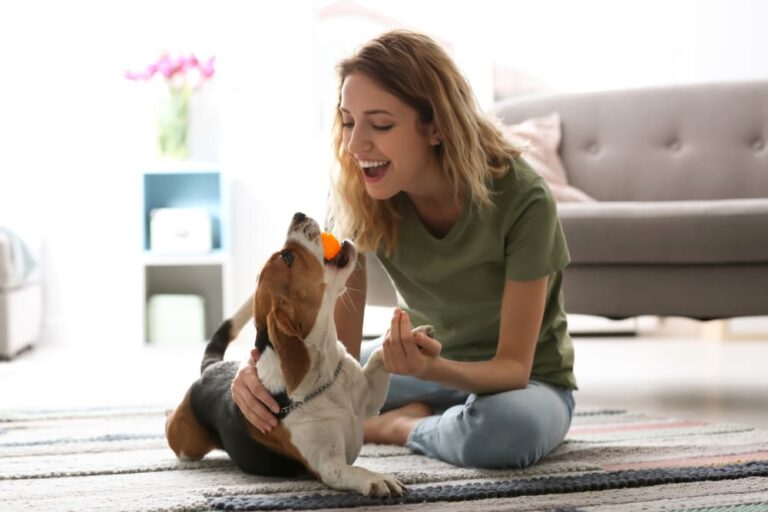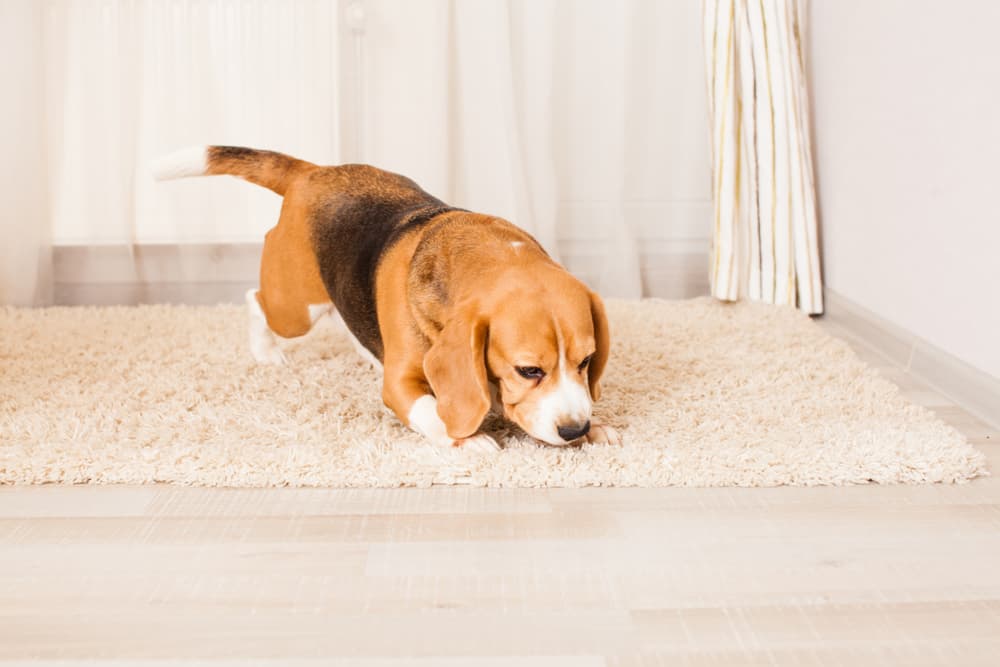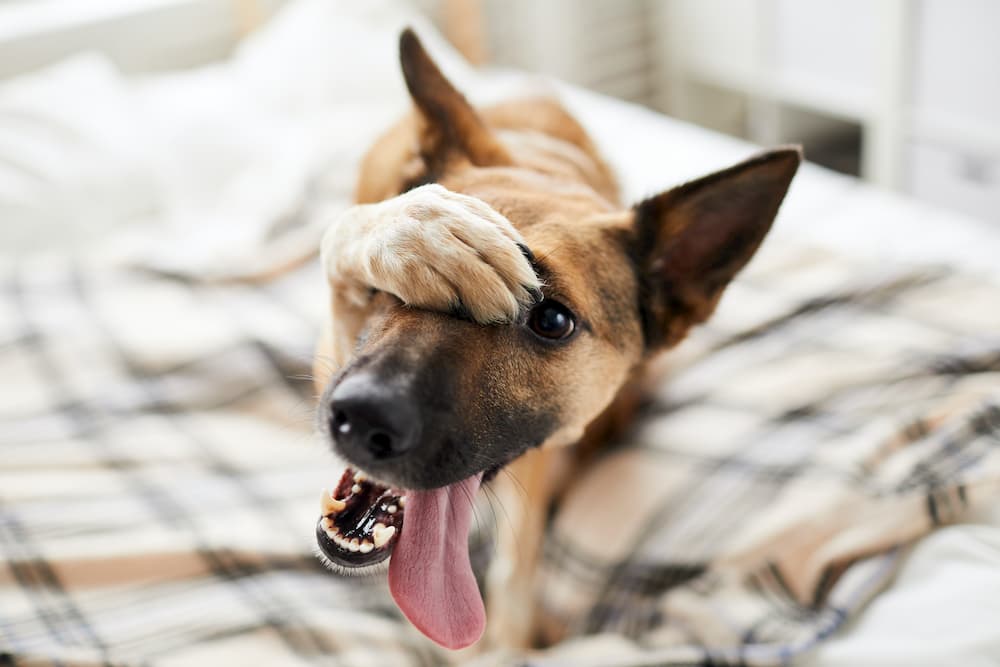9 Simple Ways to Bond With Your Dog at Home

Bonding with your dog can help make stressful times more bearable. In fact, experts, including those at the Human Animal Bond Research Institute, say that interacting with pets can reduce feelings of loneliness, anxiety, and depression.
We asked animal behaviorists, certified dog trainers, and veterinarians to offer their best advice on how to effectively build a bond with your dog at home. Dogs are individuals, and what works for one may not be suitable for another, so check with your veterinarian before starting any new program.
Do Dogs Bond With Humans?
Ever since dogs were domesticated about 15,000 years ago, our bond with them has been unbreakable. When your dog greets you at the door with a wagging tail or curls up next to you because he senses you’re having a bad day, he is demonstrating that bond.
This bond is just as obvious when it’s been broken. “We see evidence in problems like separation anxiety, a dog’s dejection when being left with strangers, or relinquished to a shelter, and the sometimes overwhelming response some dogs show when they hear their owners’ voices after an absence,” says Dr. Liz Stelow, chief of service of Clinical Behavior Service at the Veterinary Medical Teaching Hospital at University of California, Davis.
These strong bonds don’t develop without effort on your part, however. “We do see stronger relationships between dogs and their pet parents when they are doing things together such as taking walks and doing training,” says Robin Bennett, a certified dog trainer and co-founder of The Dog Gurus.
How to Bond With Your Dog: Tips and Advice

Bonding also requires an understanding of canine nature. Here are a few things experts would like you to consider.
Dogs need to be respected as individuals. Bonding with a dog is like fostering a friendship with another person, says Stelow, who is board-certified in veterinary behavior. “It can’t be forced, but it can be encouraged in many of the same ways. Look for common interests and preferred activities, share quiet moments, engage in mutually acceptable affection, play interactive games, always be nice.”
Look at things through your dog’s eyes. “People tend to interact with every dog in the same way: they move toward them, lean over, look them in the eye, and thump them on the head. The truth is that many dogs are intimidated by the eye contact and head-thumping, and would prefer getting treats, walking together, and getting soft neck rubs,” offers Dr. Terri Bright, director of Behavior Services at MSPCA-Angell in Boston.
Get to know your dog’s body language. Try to understand what your dog wants to express before he expresses it, recommends Meredith Biehl, a certified dog trainer and owner of Thinking Dog Dog Training & Behavior Consulting in the Milwaukee, Wisconsin area. “The better you can read your dog and what he is trying to communicate to you, the better you can support your dog through situations and throughout life, thus improving your dog’s trust in you.”
Be consistent. Dogs thrive on predictability, says Bright. “If your dog can predict when a meal will come, when a neck rub is available, when play time occurs, they will be more likely to spend time near to a person.”
Quality is more important than quantity. Training sessions don’t have to be drawn out to be effective. “I like to train for very short periods several times a day. For instance, I take out five treat rewards and train until they’re gone. This is a great way to break up your at-home work day, as this is easily attainable between work tasks like reading emails, finished projects, and online meetings,” says Jenn Fiendish, a veterinary behavior technician who runs Happy Power Behavior and Training in Portland, Oregon.
Consider your dog’s temperament. Dogs with fear or anxiety issues don’t trust as easily, says Fiendish. “For these dogs, it’s best to move at a slower, more hands-off pace. Instead of forcing interactions like petting or snuggling, allow the dog to approach you at his own pace. Once your dog is near you, allow him to make the decision to stay or go.”
Think ahead (if your current schedule isn’t permanent). While many dogs will readjust to your old schedule with few issues, “There is a risk of some dogs developing behavior problems going from additional attention and time together to less,” says Biehl, who is also a certified trick dog instructor through Do More With Your Dog.
If you currently work from home, ensure your dogs still have alone time, recommends Stelow. “That way, when the owners [are] gone for hours at a time, the dogs won’t feel quite so unsettled.”
Best Ways to Bond With Your Dog at Home
Here are some fun ideas for bonding with your dog at home. Keep in mind that every pet (and person) will have his own preferences, so find something you enjoy doing together.
Play Indoor Parkour

Parkour is a fun, low-impact, non-competitive sport in which a dog navigates physical obstacles. It’s similar to agility sports, but less structured. “Parkour teaches dogs to interact with objects in their environment by going around, putting two feet on, going in, jumping over, climbing under, and on various objects. While teaching the skills, reinforcement like treats, praise, toys, or petting are used to reward the dog for trying,” explains Biehl, who is a certified parkour instructor through the International Dog Parkour Association. The benefits? “A dog learns to be more confident while getting a great mental and physical workout.”
While parkour has traditionally been an outdoor activity, the International Dog Parkour Association also has a program for indoor parkour that you can try at home.
Choose Enriching Toys

There’s a lot of variety when it comes to dog enrichment products, from chews and puzzles to food toys. “Learning what your dog likes and doesn’t like is key,” offers Dr. Carley Faughn, senior manager, behavioral rehabilitation and research at Best Friends Animal Society. “Kongs are great because you can stuff them with peanut butter, your dog’s kibble, small treats, canned dog food and then you can freeze them for later use.”
If using a new food puzzle, Faughn recommends observing how your dog reacts to it, and that it’s safe and enjoyable. If a particular puzzle isn’t working out, she suggests trying something new, like a different toy or higher value food item. “Some puzzles are very easy for dogs to solve, while others can be more challenging and cause frustration. We don’t want that, and if you notice frustration, then it’s okay to remove the puzzle but always give them something tasty anyway because they likely wanted the food but weren’t motivated to work that hard for it.”
Engage Your Dog’s Natural Stalking and Chasing Behaviors

One way to promote your dog’s natural stalking and chasing instincts is to use a flirt pole, which is essentially a giant cat toy wand for dogs that you can purchase or make at home, says Faughn.
“This can simply be a fun game of swinging the pole around with a toy at the end and letting your dog catch it. Or, you can make it more advanced by adding rules to the game, such as teaching your dog to ‘drop it’ when asked and then ‘take it’ when asked. This can help your dog with impulse control, while building a fun relationship with you at the same time. You want your dog to catch the toy to decrease the likelihood of frustration.”
Put Your Dog’s Nose to Work

“This is one of my favorite games to implement with my dogs at home and in shelters, because it is so easy and taps into their natural scavenger and foraging abilities in their hunt for food,” says Faughn. There are various ways to approach this, she says. “The typical beginner way is to set up two to four boxes in a room, bait each box with a high-value, tasty, smelly treat, and then release your dog and say, ‘find it!’ The dog then searches for the smelly food you baited the boxes with and gets to enjoy using their brain and natural senses to problem solve. Initially, the boxes serve as visual identifiers for the dogs to explore and locate food.”
When your dog achieves this level, you can make it more challenging, she says. “If you had four boxes baited, decrease it to three of the four boxes now having tasty treats. Eventually, you can take the boxes away completely and strategically place your high-value treats around your house or specific room.”
Tap into the Power of Touch

What dog wouldn’t appreciate a soft, gentle massage? Although the research on massage for dogs is scant, some veterinarians believe it’s associated with benefits like stress relief and lowered blood pressure.
Use your fingertips to create soft, circular motions. “Have your dog relax and massage him gently. Most dogs love having their neck or chest massaged,” says Bennett. “You might find other favorite spots on your particular dog, such as the hindquarters or head or ears. Watch as your dog relaxes as you massage. You might relax too.”
Practice Basic Training

Bennett recommends choosing a simple behavior to teach your dog, then working with him five to six minutes each day using positive methods to build a stronger relationship. “As both of you learn, you will develop mutual trust and understanding and ultimately strengthen your bond,” she says
Rewards reinforce behavior. If using treats as rewards, they don’t have to be giant-sized, says Fiendish. “I cut up all my rewards so that they’re around 1/8 of an inch. I can make one 1-inch treat into 8 treats. I want to reward my dog a lot but not make him fat.”
Teach Your Dog New Tricks

Tricks can take training to the next level. One simple trick Bennet recommends is the spin. “Take a treat and try to guide your dog in a circle. At first reward him with the treat if he goes a quarter turn, then half way, and then eventually all the way around,” she says. “Give this behavior a name—like spin or twirl—and keep practicing until your dog can do it without needing to be lured with the treat.”
Trick training exercises the dog’s mind and body, and helps strengthen your bond by increasing confidence and trust, says Fiendish, who also serves as executive director of the Society of Veterinary Behavior Technicians. Tricks are fun, too. “My little dog, Stitch, is the star of any place we go to with his willingness to perform, and I’m the proudest mom when he does.”
Let Your Dog Hear the Sound of Your Voice

Bonding with your dog can be as simple as talking to him. Reading aloud is frequently used to help shelter dogs build relationships with people while reducing their stress, says Faughn. “Your dog might not be stressed at home, but sometimes we all need a little help to take a deep breath. Reading aloud to your dog can help both of you. Our dogs tend to enjoy hearing familiar voices and this opportunity allows for that while giving you the opportunity to read something you enjoy.”
Throughout the day, Fiendish asks her dog for advice about current projects. “He even attends online meetings so that he can assure that our company continues to run smoothly. He has his own area in my office and has even been promoted to Chief Barkerations Executive.” She says working at home has been excellent for the bond between her and her dog.
Go Outside

Taking a walk with your dog around your neighborhood is a good bonding activity. Faughn puts walks into two categories. “I call free walks those in which I don’t have any training goals in mind,” she says. “Free walks allow the dog to sniff and explore, let them lead you but of course keep them out of trouble.”
Training walks incorporate training such as working on commands like “sit” in new environments, she says. “Of course, allow your dog to sniff and enjoy the environment during training walks as well.”
Bonding With Your Dog: A Lifetime Goal
Keep in mind that finding ways to bond with your dog is a permanent journey, and that training isn’t a one-and-done effort.
“Training throughout your dog’s life not only creates a more intelligent dog, it helps prevent behavioral problems like destructive behavior, nuisance behaviors, reactivity, and separation anxiety to name a few,” says Fiendish.
During times of high stress, there’s perhaps no greater source of comfort than your best friend. Any time you spend at home is an ideal time for bonding with your dog.









